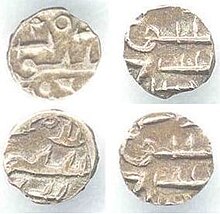Mansura (Brahmanabad)
This article needs additional citations for verification. (February 2011) |
منصورہ Template:Ur icon | |
 Coins during the rule of Amirs of Sind, c. 257 -- 421 AH / c. 870 -- 1030 AD | |
| Lua error in Module:Location_map at line 425: No value was provided for longitude. | |
| Location | Sanghar District, Sindh, Pakistan |
|---|---|
| Type | Settlement/Capital City |
| Part of | Umayyad Caliphate in Sindh |
| History | |
| Periods | 8th Century |
| Cultures | Umayyad Caliphate in Sindh |
Mansura (Arabic: منصورہ) was the historic capital of the Arab empire in Sindh, Pakistan during the eighth century under the Umayyad Caliphate.[1] The city now lies in Sanghar District situated about 8 miles (13 km) south-east of Shahdadpur, Sanghar District, and 43 miles (69 km) north-east of Hyderabad.[citation needed]
History
The city was constructed by Khalid ibn Barmak (705–782), a member of the Persian Barmakids family. The city holds an important position in Muslim history as the first to be built by Arabs according to the principles of town-planning. Seventeen years later, lessons learned in Mansura were applied in Baghdad where there were once numerous Sindhi inspired buildings and monuments.
Mansura's history began under the Umayyad Caliphs, when Muslim Arabs attempted to conquer the frontier kingdoms of India, Kabul, Zabul, and Sindh. In the early 8th Century, with the Kingdom of Sindh convulsed by internal strife, the Arabs seized their chance and renewed their attacks. Thereafter it was captured by Muhammad ibn Qasim, nephew of al-Hajjaj ibn Yusuf, the governor of Iraq and Khurasan. Qasim's successors attempted to expand from Sindh into the Punjab and other regions. Al-Masudi ascribed the foundation of the city to Governor Mansur ibn Jamhur, the last Umayyad governor of Sindh. Umar ibn Abd al-Aziz, who belonged to the Banu Habar tribe, the clan of Banu Asad, was the first governor of al-Mansura. Under the Caliphate of al-Mansur, Khalid was appointed governor of Fars and, after helping obtain Prince Isa ibn Musa's renunciation of his succession to the caliphate in 765, became governor of Tabaristan. Around the same time, his son Yahya ibn Khalid, was appointed governor of Adharbayjan.
According to historians[clarification needed Who?], Mansura was a beautiful town with vast orchards of mangoes and groves of date palms. Today the ruins of Mansura are spread over an area 4 miles (6.4 km) in circumference near the modern city of Shahdadpur. The most significant ruin found in Mansura is the large courtyard of a Jamia Masjid (mosque), while the remains of temples destroyed by the Muslims were re-used to build mosques, leaving no remains other than a small temple structure called a deri (or deval), which may have been related to the practice of sati.
Modern ruins
The city lies upon the open sandy plain amongst rolling heaps of brick debris, crisscrossed with the depressions of its original streets and surrounded by the ruins of its once massive walls and bastions. Shaped like a boot with the sole facing north-west and the leg stretching south-east, the whole area has a circumference of 5.75 miles (9.25 km). Apart from a considerable area towards the south-east end, the whole space is covered with billowing mounds of brick ruins. Nothing now stands above the surface, except in one place, where an unrecognizable tower-like core of brick masonry remains. There is a total absence of stone masonry of any kind, but lumps of charred wood dotted here and there indicate the former presence of woodwork. The cement used in the brickwork appears to have been mud which forms the greater mass of the present mounds.[citation needed]
The name Brahmanabad too was a misnomer and is primarily based upon the assumption that it was the place where Brahmans were concentrated. It is a combination of Brahman and Abad. Abad means settled and is a Persian word. It is simply impossible that the Brahmans could have named the city Brahmanabad using a Persian suffix because the indigenous Sindhi language, or its previous regional dialects, was rich with many such words as waahn, wasti, waari, etc. In fact the city was established earlier than the Brahman occupation of, and settlement in, the site, by the Persian Sassanid King Bahmanwa. This information is based on the historical works of Maj Raverti, a prominent historian on the North Western parts of India, particularly, Sindh.
See also
References
- ^ Hussain, Irshad. (1989). Mansurah - The First Capital of Muslims in Sindh. Journal of the Pakistan Historical Society 37(3): 293-303.
Further Reading
- Avari, B. (2012). Islamic civilization in South Asia: A history of Muslim power and presence in the Indian subcontinent. London: Routledge.
- Rashid, N. (1998). Al-Mansurah-The Lost City. Journal of the Pakistan Historical Society 46(4).
- Mansura Archaeological Site Photo
- Sindh Archaeology
